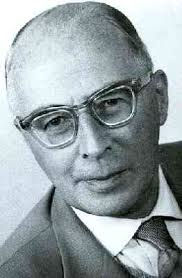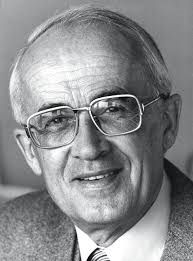The FHS roots
The origins of the FHS include many pioneers from the history of German industry and we continue to be inspired by their work.
Heinrich Focke (*8. Okt. 1890 - †25. Feb. 1979):

One such person is Heinrich Focke, to whom FHS owes more than just his current location in Hoykenkamp. Initially only an average student, Focke found his calling when he acquired a near-obsessive enthusiam for the fledgling aviation industry, wich led him to develop his outstanding engineering knowledge. From that time on, he was filled with the restless Spirit of inquiry until the end of his life. He was particulary fascinated by the aerodynamics in rotary-wing aircraft, such as gyroplanes, and helicopters; and together with Gerd Achgilis, he developed the first flyable helicopter in the world. You can still visit the launch site of the maiden flight here at FHS! During the Second World War, he was never comfortable with the ideas of National Socialism, and he declined several appointments to high positions in the German Luftwaffe, which caused him reprisals in his entrepreneurial activities. After the Second Word War, he used his knowledge to promote helicopter development in France and aircraft constructions in the Netherlands and Brazil, and his innovations are still found in today's aircraft. And although his successes in aviation aremore commonly known, he also made contributions to ship- and housebuilding.
Walther Blohm (*25. Jul. 1887 - †12. Jun. 1963):

Friedrich Walther Blohm, scion of the Blohm Family, was groomed as successor to the Blohm & Voss dynasty from an early age. It is noteworthy that he never felt his predestined life was burden, but rather a vocation, and he mastered his broad, interdiscilinary education with extraordinary discipline and bravado. He applied his extensive knowledge to commercial, humanistic, and linguistic fields, but above all, he focused on the field of engineering. Associated with hanseatic and moral principles of the Blohm dynasty, he is considered one of the last real great patriachs in German entrepreneuship. There was no detail in his company which he did not know and his door was always open. He believes that "his" product's quality would speak for itself and consequently acquisition was not necessary. His motto was: "The customer comes to us!". Therefore, it is not suprising that he did not get along with the ideals of the National Socialists, with whom he - unlike his brother Rudolf - constantly fought difficult and personally dangerous conflicts. Likewise, he had difficulties understanding the impersonal structures of the employee-led group, into which he was forced out of necessity during post-war Germany. This made him bitter at the end of his life, which increasingly affected his health in negative ways.
Ludwig Bölkow (*30. Jun. 1912 - †25.Jul. 2003):

Ludwig Bölkow spend his childhood in Schwerin. His father was a foreman at the Fokker aircraft factory, before it was relocated to the Netherlands in 1919. Bölkow studied mechanical engineering, specislizing in aircraft construction at the TU-Berlin. He became a driving force in the development department of Messerschmitt AG. Despite his outstanding expertise, Ludwig Bölkow was not an engineer who designed in a quiet little room. His working approach was closer to that of a modern, professional "projekt Manager" of today. He was able to motivate a team to a high degree in order to verify other than his ideas and to involve them in the "project". In addition, he was also a visinary, who promoted and for example the use of solar energy, hydrogen engines and magnetic levitation trains. He was in charge of the development of the first jet airliner, the Me 262. On the design of this aircraft; with nose landing gear, swept-up wings, the surface profile itself, low-wing design with hanging engine gondolas, the majotority of jet engine-powerd aircraft are still based today! Other successes in post-war Germany were as examples the first aircraft made by fiberglass and "his" helicopter, the Bo 105. The rotor head developmend by Bölkow is used in almost every detail today in the Kawasaki BK 117 helicopter!
Anton Herman Gerard Fokker (*06. Apr. 1890 - †23. Dez. 1939):

"Anthony" Fokker was a bustling „jack of all trades“ and a cosmopolitan. As the son of a Dutch coffee plantation owner in Indonesia, in addition to his Dutch citizenship he acquired German and American citizenship to be allowed to produce military aircraft in the respective countries. The engineering skills of "Anthony" Fokker are controversial as the authorship of his inventions was often doubt. As an example, although the patent is in Fokker's name, the mechanism for synchronizing the firing of a plane's machine gun with the plane's propeller might have actually been the work of his employees. Holder of the Aéronautique Internationale (FAI) No 88 flying license, Fokker always demonstrated a high degree of willingness as an entrepreneur to take action and risk, wich paid off after a difficult period in 1914. Participating in the First World War, his company grew from 100 to about 6,000 employees. He owed factories in Schwerin, Lübeck, Travemünde, Berlin, in the Taunus and in Hungary. After the First World War, he relocated in a coup d'ètat all production to Veere in the Netherlands due to the restictions of the treaty of Versailles. In 1922, he founded the Fokker Aircraft Corporation in the United States, wich did not recover from the 1929 stock market crash on Wall Steet. Fokker died at 49 years of infection as a result of surgery. His last position was that of the European representative of his former competitors in the US, Douglas and Lockheed.
Wilhelm Emil Messerschmitt (*26. Jun. 1896 - †15. Sep. 1978)

Although born as a son of a wine merchant, the interests of "Willy" Messerschmitt were devoted to engineering in general, and aircraft- technology specifically, since early childhood and he founded his first aircraft manufacturing company while still studying engineering. Willy Messerschmitt worked as an entrepreneur, designer and apprentice and suffered great successes and drastic defeats in all three areas. Politically, he was controversial due to his close proximity to National Socialism, although his sometimes independent, stubborn character did not make him a clear-cut favorite of the system. Nevertheless, his great achievements in the construction are widely acknowledged. He is considered one of the fathers of modern lightweight aluminum construction in aircraft. He is closely linked to what was the standard fighter of the German Air Force in World War II, the Me (Messerschmitt) 109. After the Second World War, he concerned himself with housing, vehicles (Messerschmitt cabin scooters) and even sewing machines before he went back to the aviation industry. Finally, under the umbrella of the Spanish and Egyptian governments, he produced aircraft in Germany again. The death of his beloved wife "Lilly" in 1972 was a fatal blow for Messerschmitt, from which he never fully recovered.
